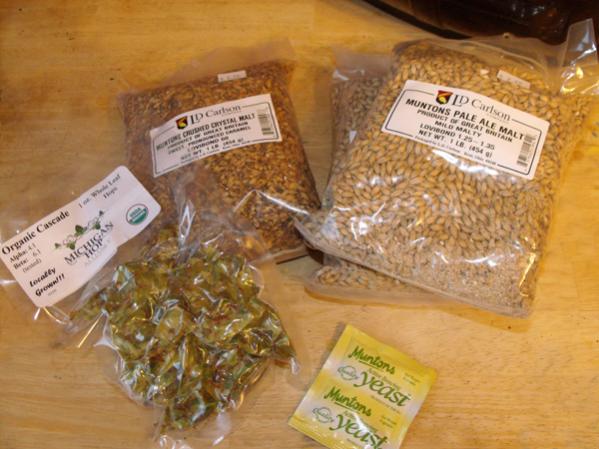A few weeks ago I bought a Mr. Beer as I have been very interested in starting homebrewing for some time but wanted an easy way to get into it in an inexpensive way. I was in the Navy for 6 years and developed a serious love for beer and really wanted to brew but never had time and now since I'm in college I have loads of time.
GI Bill is sweet, idn't it?

I started my first batch right when I got the product in the mail. I followed the directions provided with the Mr. Beer kit and felt pretty good about the whole process. It hasn't started warming up here yet so my house is still relatively cold (we keep it in the mid to mid-upper 60's). I keep the keg in the upstairs bathroom which has the best temperature control and is also the warmest room in the house.
If the ambient temperature is in the mid-60's, the fermentation can be 5-10 degrees fahrenheit higher than that, due to the yeast's metabolic activity.
A few days ago I bottled the batch, which was 17 days after I started the brew. As I was bottling it (I was using growlers (sp?) from beer that I had bought from microbrews in the past) I noticed the beer looked very light (was using the West Coast Pale Ale recipe). I didn't check up on the beer much as it was fermenting as I simply figured it was idiot proof but this seemed peculiar. I also tasted a slight bit and it tasted a bit funny. I guess I'll see in a few weeks after carbonating to see how it is.
You should only bottle in growlers rated for pressure, i.e., the swing-top kind. Even then, you are kind-of taking a risk. Bottle bombs are not fun!
By "light", do you mean it looked like a Coors light, or was it opaque? If it was *transparent* and light, it's fine; if it was *opaque* and light, then your yeast weren't done with the beer yet, and it was still fermenting.
Unfortunately, fermenting beer is not quite "idiot-proof".

It is pretty easy, but it's not quite idiot-proof. If you have good sanitation, good temperature control, good patience and you use sane recipes, then you will get good beer. So, that's about four degrees removed from idiot-proof, sadly.
As for tasting un-carbonated beer, sometimes it tastes good and sometimes not. If it tastes good flat, then it will taste good carbed. If it doesn't taste good flat, then it still *might* taste good carbed. It's hard to judge accurately from that taste.
As for tasting funny, check this page:
http://www.homebrewzone.com/off-flavors.htm
Now to my main question. I understand that too high of a temperature is bad because of the microbiology with yeast, but is it possible to be in a too cold temperature? By too cold I'd mean low 60's, nothing lower. I may run in to a problem this summer with finding an adequate room in the house to keep my brews at the proper temperature. Thanks for the help!
It is possible to be too cold. What that does is slow the yeast down, so that the beer takes longer to ferment. The low 60's, considering the added heat from yeast metabolism, was not cold enough for that -- it takes more like the 40's for several weeks to kill yeast. So low temp was probably not your problem. You definitely need to look into a swamp cooler set up (threads on this site aplenty), especially going into the summer brewing season. Either that, or brew a bunch of wheat beers!!

* Also wanted to ask about water quality. I think my tap water is pretty good, should I get a water analysis from the city while using Mr. Beer or should I be fine. My place doesn't have a water softener or any of that fancy crap, just straight city water.
If it tastes okay to drink, it's okay to brew with. However, your brews will get better if they have better water. I usually buy it from the store (Spring water is my favorite), but my buddy has a built-in Brita for his fridge and he uses that.
Enjoy college, sailor!








































![Craft A Brew - Safale S-04 Dry Yeast - Fermentis - English Ale Dry Yeast - For English and American Ales and Hard Apple Ciders - Ingredients for Home Brewing - Beer Making Supplies - [1 Pack]](https://m.media-amazon.com/images/I/41fVGNh6JfL._SL500_.jpg)



















